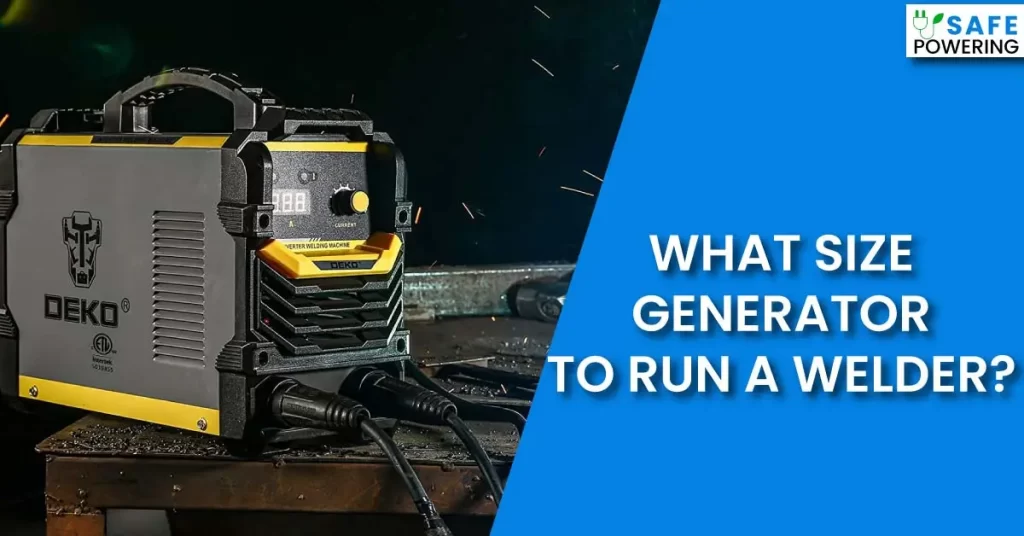What Size Generator to Run a Welder? – [A Helpful Guide]
Wondering “what size generator to run a welder?” Our expert tips and tricks will help you select the best generator wattage to maximize your welding output.
The size of the generator you need for welding will depend on several factors, including the type of welder you’re using, the amperage and voltage requirements of your welder, and the size and thickness of the metal you’re welding.
Choosing the wrong size generator can result in poor weld quality, inconsistent performance, and potentially even damage to your equipment.
The size of the generator required for welding is highly dependent on the type and size of the welder being used. For small MIG and portable 120-volt welders, a generator with a power output between 5000 to 7000 watts is generally enough. However, larger arc welders with higher amperage requirements will require much larger generators with outputs of over 50 amps.
In this article, we’ll explore the factors that determine what size generator you need for welding and provide some tips on the subject.
What Size Generator To Run a Welder At Jobsite?

There is some factor you should look into before purchasing a generator for your welder.
If a generator can’t produce enough power, you may end up damaging the welding setup.
If the generator power rating is too high, it will be a hassle to move it around and its cost will be on the higher side.
I have seen job site people end up spending more on the generator than the welder itself so don’t make that mistake. Let’s see some of the factors you should be looking at:
While we are on the subject, read our guide on what size generator can run a refrigerator.
We have also written an extensive guide on the generator size required for a 50-amp RV.
1. Determine the Power Requirements of Your Welder:
The amperage and voltage requirements of your welder will determine the amount of power it needs to operate properly.
You can typically find this information in the welder’s manual or specifications sheet. We will also tell you how to do that by yourself.
It’s important to use the correct amperage and voltage information, as using a generator that doesn’t meet your welder’s power requirements can result in poor weld quality or even damage to your equipment.
2. Calculate the Wattage Required:
Once you know the amperage and voltage requirements of your welder, you can use the formula Watts = Volts x Amps to calculate the wattage required.
This will give you the minimum amount of power your generator needs to provide to operate your welder.
Keep in mind that this is only the minimum, and you will likely need to add some extra wattage to account for startup and surge currents.
3. Add Extra Wattage:
Adding extra wattage to your calculations can help ensure that your generator can handle the power demands of your welder.
As a general rule of thumb, it’s recommended to add 15% to 20% to your calculated wattage to account for startup and surge currents.
This will help prevent your generator from tripping its circuit breaker or overloading, which can cause damage to your equipment.
4. The Type of Welding You’ll Be Doing:
The size and thickness of the metal you’ll be welding will impact the generator size you need.
If you’re planning to weld thicker materials, you’ll need a generator with a higher amperage output.
It’s important to choose a generator that can handle the maximum amperage you’ll be using, as using a generator with a lower output can result in poor weld quality or equipment damage.
5. Choose a Generator with the Right Output:
Once you’ve determined the wattage required for your welder and the type of welding you’ll be doing, you can choose a generator with the appropriate output.
Make sure the generator you choose can provide enough power to meet the demands of your specific welding application.
It’s always better to choose a generator that’s slightly larger than you think you’ll need, as this will provide some extra capacity for future needs or unexpected power demands.
Recommended Read: What Size Generator for Construction Site?
How Many Watts Does My Welder Use?
The formula for calculating the wattage of your welder is:
Watts = Volts x Amps.
For example, if your welder requires 220 volts and 50 amps, the wattage would be:
Watts = 220 x 50 = 11,000
So, your welder requires 11,000 watts to operate properly.
You may need to add some extra wattage to account for startup and surge currents.
I have already mentioned above, it’s recommended to add 15% to 20% extra to your calculated wattage to ensure that your generator can handle the power demands of your welder.
Here is some more example:
Example #1
- Voltage Requirements: 120V
- Amperage Requirements: 20A
- Wattage = Volts x Amps
- Wattage = 120 x 20
- Wattage = 2400
So, this welder requires 2400 watts to operate properly.
Adding 15% extra = 360 watts
Total watts required = 2760 watts.
You will need a 3000 to 3500 watts generator.
Example #2
- Voltage Requirements: 240V
- Amperage Requirements: 30A
- Wattage = Volts x Amps
- Wattage = 240 x 30
- Wattage = 7200
So, this welder requires 7200 watts to operate properly.
Adding 15% extra = 1080
Total watts required = 8280
You will need an 8500 to 9000 watts generator.
Example #3
Voltage Requirements: 240V
Amperage Requirements: 50A
Wattage = Volts x Amps
Wattage = 240 x 50
Wattage = 12,000
So, this welder requires 12,000 watts to operate properly.
Adding 15% extra = 1800
Total watts required = 13800
You will need a 15000W generator.
Compatible Extension Cords for Welding Machines
| Wattage Rating | Suitable Length For 10 Gauge Cord | Suitable Length For 12 Gauge Cord | Suitable Length For 14 Gauge Cord | Suitable Length For 16 Gauge Cord |
| 5000 Watts | Up to 250 feet | Up to 150 feet | Up to 100 feet | Up to 75 feet |
| 7500 Watts | Up to 125 feet | Up to 75 feet | Up to 50 feet | Up to 25 feet |
| 10,000 Watts | Up to 60 feet | Up to 35 feet | Up to 25 feet | Up to 10 feet |
| 15,000 Watts | Up to 30 feet | Up to 15 feet | Not Suitable | Not Suitable |
Generators Suitable for Welding
| Approximate Welder Amperage | Minimum Required Generator Wattage | Recommended Generator Wattage |
| Less than 100 Amps | 3000 Watts | Up to 4500 Watts |
| 100 to 160 Amps | 4500 Watts | Up to 6500 Watts |
| 160 to 200 Amps | 6500 Watts | Up to 8000 Watts |
| 200 to 250 Amps | 10000 Watts | Up to 13000 Watts |
Which Factors Affect the Generator Choice for Welders
1. Welder Type:
The type of welder you are using will play a big role in determining the size of the generator you need.
For example, smaller MIG and portable 120-volt welders can typically be run off a 5000 to 7000 watts generator, while larger arc welders will require a much larger generator, upwards of 50-amp output.
2. Power Requirements:
The power requirements of your welder are another important factor to consider.
As mentioned earlier, you will need to calculate the wattage of your welder to determine the appropriate size generator to use.
Make sure to factor in any additional power needed for startup and surge currents.
While we are on the subject, read this book about welding safety. It is extremely important to follow all the safety guidelines we doing dangerous work.
3. Duty Cycle:
The duty cycle of your welder refers to the amount of time it can operate continuously without overheating.
Higher-duty cycle welders will require more power and may need a larger generator to operate effectively.
4. Location:
Where you will be welding is another important consideration. If you will be working in a remote location, you will need a generator that is portable and easy to transport.
Additionally, if you will be working in an area with limited access to power, you may need a larger generator to provide the necessary power for your welder.
5. Fuel Type:
The type of fuel your generator uses will also be an important consideration.
Gasoline, diesel, and propane generators all have their own advantages and disadvantages, so you will need to choose the type of fuel that best suits your needs.
What are the Best Generators for Welders?
| Generator | Brand | Type | Output Power | Welding Output | Fuel Capacity | Run Time (at 50% load) | Noise Level |
| Miller Bobcat 260 | Miller Electric | Gasoline | 11,000 watts | 260 amps DC | 12 gallons | 13 hours | 74 dBA |
| Lincoln Ranger 330MPX | Lincoln Electric | Gasoline | 10,500 watts | 330 amps DC | 12 gallons | 15 hours | 70.5 dBA |
| Hobart Champion Elite | Hobart | Gasoline | 11,000 watts | 225 amps DC | 10 gallons | 8.5 hours | 73 dBA |
| Honda EB10000 | Honda | Gasoline | 10,000 watts | N/A | 8.1 gallons | 7.2 hours | 76 dBA |
| Generac GP15000E | Generac | Gasoline | 15,000 watts | N/A | 16 gallons | 10 hours | 78 dBA |
What Size Generator for A 220V Welder?
The size of the generator required for a 220V welder will depend on the amperage draw of the welder. Here’s a general formula to help you calculate the required generator size:
Generator Size (in watts) = Welder Amps x Volts x 1.5
So, if you have a 220V welder that draws 50 amps, the minimum generator size you would need is:
Generator Size = 50 amps x 220V x 1.5 = 16,500 watts or 16.5 kW
However, it’s always a good idea to consult the manufacturer’s specifications for your specific welder to determine the recommended generator size.
The manufacturer may have specific requirements based on the type of welding process, electrode size, and other factors.
You might also want to run a furnace on the site, so read our article on the generator size required for a furnace if you can spare some minutes.
Can You Run A Stick Welder On A Generator?
Yes, you can run a stick welder on a generator, as long as the generator is of the appropriate size and has the necessary features to support the welding process.
The main consideration when running a stick welder on a generator is the generator’s capacity to provide enough power to support the welding process.
Stick welding typically requires a higher current draw than other types of welding, so the generator should be sized appropriately to meet the welder’s amperage requirements.
Additionally, the generator should be a high-quality model that is designed for use with welding equipment.
It should have features such as a stable output voltage, good voltage regulation, and a smooth sine wave output to ensure consistent performance and avoid damaging the welder.

Fareed, the highly skilled electrical expert, boasts 5 years of extensive experience in proficiently maintaining, repairing, diagnosing, and installing a diverse range of electrical systems.
